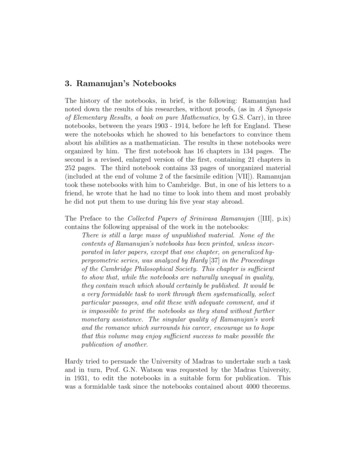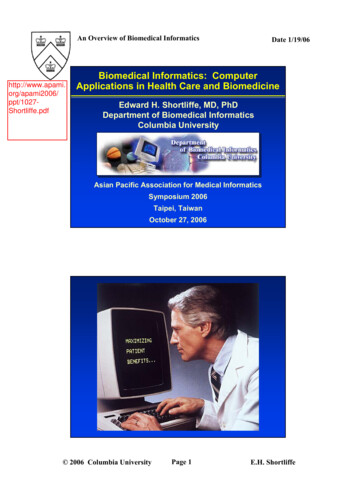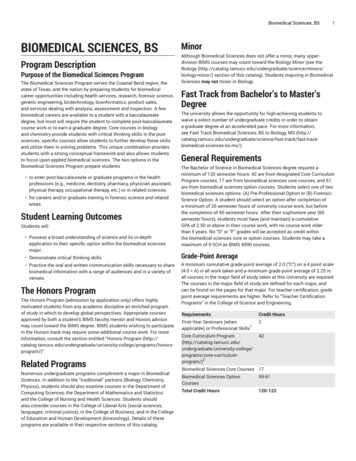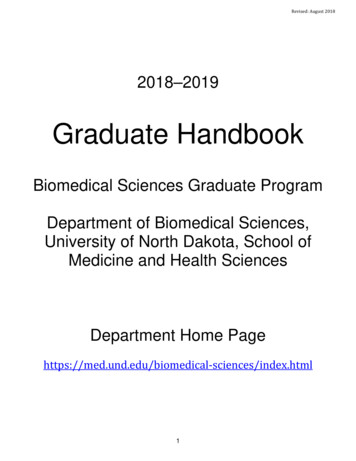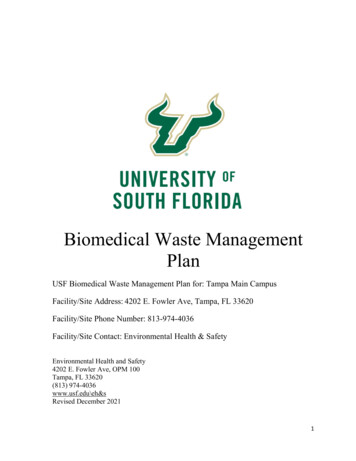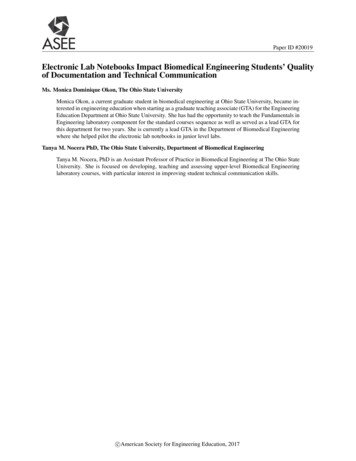
Transcription
Paper ID #20019Electronic Lab Notebooks Impact Biomedical Engineering Students’ Qualityof Documentation and Technical CommunicationMs. Monica Dominique Okon, The Ohio State UniversityMonica Okon, a current graduate student in biomedical engineering at Ohio State University, became interested in engineering education when starting as a graduate teaching associate (GTA) for the EngineeringEducation Department at Ohio State University. She has had the opportunity to teach the Fundamentals inEngineering laboratory component for the standard courses sequence as well as served as a lead GTA forthis department for two years. She is currently a lead GTA in the Department of Biomedical Engineeringwhere she helped pilot the electronic lab notebooks in junior level labs.Tanya M. Nocera PhD, The Ohio State University, Department of Biomedical EngineeringTanya M. Nocera, PhD is an Assistant Professor of Practice in Biomedical Engineering at The Ohio StateUniversity. She is focused on developing, teaching and assessing upper-level Biomedical Engineeringlaboratory courses, with particular interest in improving student technical communication skills.c American Society for Engineering Education, 2017
Electronic Lab Notebooks Impact Biomedical EngineeringStudents’ Quality of Documentation and TechnicalCommunicationAbstractLaboratory notebooks have long been used as a tool to develop student documentation andtechnical communication skills in laboratory courses. Given the presence of social media as wellas other methods of electronic communication, computer mediated activities provide anopportunity to educate students in a familiar setting. For this reason, we have pursued a study tomeasure the impact of electronic laboratory notebooks (ELNs, LabArchives Classroom Edition)on the quality of upper-level biomedical engineering students’ documentation and technicalcommunication skills. A total of thirty-three ELNs submitted by students enrolled in abiomechanics lab course during autumn 2016 and thirty-three paper-based notebooks submittedby students enrolled in the same course during autumn 2015 were selected for this study.Notebooks were quantitatively analyzed against a rubric designed to measure how well theselected notebooks met assessment criteria in the categories of communication, documentationand presentation. Results showed significantly higher overall mean and category-specific scoresfor ELNs compared to paper-based notebook submissions (p 0.05). It was concluded that labnotebook keeping in an electronic format may be an effective medium for aiding students inimproving documentation and technical communication skills.IntroductionThe use of cloud computing, digital technology, and social media has increased in education,scientific research, and the Science Technology Engineering and Mathematics (STEM)industries [Guerrero 2016; Machina 2013; Pence 2016]. ABET has indicated that preparingengineering students in technical communications is one of the essential skills needed to enterthese fields [ABET 2016]. As a result, technical communication in the electronic setting may bea critical skill for engineering students seeking employment.One way for students to gain and practice documentation and technical communication skills ina practical setting is through the experiential courses throughout the curriculum (i.e. laboratorycourses). In autumn 2016, we transitioned the biomedical engineering laboratory course,biomechanics, from paper-based to electronic-based laboratory notebooks (ELNs) usingLabArchives Classroom Edition.The role of ELNs is similar to paper-based lab notebooks in which students practice recordkeeping in a laboratory setting. In order to properly keep records, students practice collecting,storing, and presenting data, as well as summarizing their methodologies, observations, andresults. However, the effectiveness of ELNs on improving the quality of biomedical engineeringstudents’ documentation and technical communication is not well studied. Therefore, thepurpose of this study is to determine whether the ELN format improves biomedical engineeringstudents' documentation and technical communication skills, compared to a more traditionalpaper-based laboratory notebook format.
MethodsParticipants in this study were junior and senior level biomedical engineering undergraduatestudents who were enrolled in the biomechanics lab course during autumn 2015 or autumn 2016.The students enrolled in the autumn 2015 cohort were required to keep lab notebooks on paper,whereas those enrolled in the autumn 2016 cohort were required to keep electronic labnotebooks (ELNs) using department-purchased subscriptions to LabArchives Classroom Edition.Otherwise, all other aspects of this course, including instruction and student learning objectives,were identical. There was also no significant difference between overall final laboratory scoresof both student cohorts (p 0.78), indicating a similar caliber of students and thereby presenting areasonable comparison group for this study.During both semesters of the biomechanics laboratory, students conducted a series ofexperiments spanning over four separate course meeting days. Although experiments werecompleted in groups of two or three students, each student was required to maintain their ownindividual laboratory notebook. Students were instructed to record under prescribed headers intheir paper or electronic lab notebooks, namely “Title,” “Objective,” “Materials and MethodsNotes,” Observations and Other Notes,” and “Data.” In both semesters, an example lab notebookwith guidelines for information to include under each header was provided to the students.After each laboratory session, students received formative feedback from a teaching assistant onways to improve their lab notebooks. This feedback was verbal when the notebooks were paperbased (autumn 2015), whereas the ELN format allowed for electronic feedback to be providedvia rubrics the instructors created and imbedded within each student ELN (autumn 2016). Anexample of a student feedback rubric is shown in Table 1. Students were expected to usefeedback to improve documentation in their entire notebook (ELN format) or in future entries(paper-based format). At the end of the course, students submitted their finalized paper-based orelectronic lab notebook for summative assessment. Students could earn a total of 20 points basedon the “points possible” scores associated with the student feedback rubric, as shown in Table 1.Table 1: Student feedback rubric for laboratory notebooksSectionTitle & ObjectiveMaterials & MethodsResults & DiscussionObservations, NotesPresentationImprovementRequirementsClearly captures the daily goal(s) of the labDescriptions of experiments & materials clearly providedAll data, graphs, & relevant discussion is documentedObservations, errors, & future improvements are detailedNotebook is neat, organized, & has labeled tables/figuresAll instructor feedback was implementedTotalPointsPossible34433320After the conclusion of the lab courses, thirty-three student lab notebook submissions from eachof the autumn 2015 and 2016 offerings were analyzed to determine whether the notebook format(paper vs. electronic) impacted the quality of students’ notebook documentation and technicalcommunication. This new assessment was performed using a second rubric (Table 2), which theauthors developed to address three categories: communication, documentation and presentation.
Each rubric category included several assessment criteria, against which each student notebookwas rated. Full (2), partial (1), or no (0) credit was given for notebooks meeting, partiallymeeting, or not meeting each assessment criteria, respectively. A few notebooks were given 1.5and 0.5 credit to address distinctive responses. For consistency, this rubric assessment wascompleted by the same individual on each of the sixty-six notebooks.In the communication category, lab notebooks were assessed by five criteria. A notebook thatfully met each criterion must have included 1) a clearly written daily objective, 2) backgroundinformation that clearly supported that objective, 3) a clear description of the experiment(s)being performed, 4) a clear purpose for each experiment, and 5) overall written communicationthat met instructor expectations. In the documentation category, lab notebooks were assessed onthe detail of experimental methodology provided, the clear documentation of all observations,and the completeness and overall quality of documentation. Finally, the lab notebook’s overallpresentation was evaluated. All raw data were to be appended, and overall notebookpresentation must have been well-organized and met instructor’s expectations.All quantitative rubric assessments were recorded in excel for each student notebook (n 66),where the maximum, minimum, and average for each assessment criteria were also calculated.T- tests (α 0.05) were performed using MATLAB to compare the paper vs. ELN rubric scores.Assessment CriteriaDaily overall objective is clearly writtenBackground info clearly supports daily objectiveCommunicationof Experiment(s) Description of experiment(s) is clearly providedPurpose of each experiment is clearly writtenand PurposeOverall written communication meets expectationsSubtotal (out of 10)Documentationof ExperimentsMethods are documented in appropriate detailExperimental observations are clearly documentedDocumentations of all experiments are providedOverall quality of documentation meetsexpectationsSubtotal (out of 8)OverallPresentationAll raw data is appended to the notebookOrganization of the notebook is logicalOverall notebook presentation meets expectationsSubtotal (out of 6)Overall Score (out of 24)Does Not Meet(0)CategoryPartially Meets(1)Meets(2)Table 2: Lab notebook documentation & technical communication rubric for one course meeting
ResultsThe paper-based (autumn 2015) and electronic laboratory notebooks (autumn 2016) from thebiomedical engineering biomechanics lab course were analyzed using a rubric that was designedto evaluate the quality of students’ documentation and technical communication. Analysisrevealed a significantly higher overall mean rubric score for the ELNs compared to the paperbased notebooks (p 0.05). As depicted in Figure 1, the electronic laboratory notebooksreceived 86.3 5.5, while the paper-based notebooks received 70.9 9.8, out of 96.0 possiblerubric points.Mean Score (%)100Overall Mean Lab Notebook Rubric Scores*806040200Paper NotebooksElectronic NotebooksFigure 1: Laboratory notebooks kept electronically yielded a significant higher overall mean labnotebook rubric score (86.3 5.5 out of 96.0) compared those kept using a paper-based medium(70.9 9.8 out of 96.0). Rubric scores are presented as percentages. The rubric assessed qualityof communication, documentation and presentation. (*) α 0.05.Mean Score (%)Mean Notebook Rubric Scores by Category100***806040200CommunicationPaper NotebooksDocumentationPresentationElectronic NotebooksFigure 2: Student electronic lab notebook submissions significantly outscored paper-basednotebook submissions in all three rubric categories (communication, documentation andpresentation). (*) α 0.05.
Performance in each rubric category was also found to be significantly different (p 0.05) inELNs vs. paper-based notebooks (Figure 2). ELN submissions received an overall mean score inthe communication category of 34.2 3.4 (out of a possible 40 points), 29.2 2.4 (out of apossible 32.0 points) in the documentation category, and 23.0 1.8 (out of a possible 24.0points) in the presentation category. In comparison, the paper-based lab notebooks received anoverall mean score in the communication category of 25.9 6.0 (out of a possible 40 points),26.3 4.2 in the documentation category (out of a possible 32.0 points), and 18.7 2.5 in thepresentation category (out of a possible 24.0 points). Excerpts from a paper notebook and anelectronic notebook are shown in Figures 3 and 4, respectively.Fig 3: Paper lab notebook entry example.Fig 4 (right): ELN entry example.DiscussionIt was observed that the electronic lab notebook (ELN) format may improve biomedicalengineering students’ quality of documentation and technical communication compared to thoseusing the traditional paper-based laboratory notebook format. When comparing the scoresbetween the two groups of students in the communication category, ELN student submissionsmore often described a clear and measureable objective, clearly communicated what was beingcompleted in the laboratory session, used appropriate technical jargon, and restated the goal(s) ofthe experiment.In the documentation category, students who used ELNs were more often able to summarize thelab methodology used, discuss their experimental observations, match their observations anddiscussions to the goal of the lab, and record an overall higher quality of documentation. In thepresentation category, students using ELNs better organized their notebooks and moreconsistently documented all of their raw data compared to students using paper-based notebooks.
The electronic, cloud-based platform of ELNs offered several unique advantages over paperbased notebooks that may have contributed to improved communication, documentation andpresentation. First, documenting in a paper notebook only allows for linear entry ofdocumentation, whereas electronic notebooks allow students to re-visit, revise and addressinstructor feedback, as well as update and add to their notebooks non-linearly throughout theirlaboratory experience. This feature supports the increase in ELN scores in presentation anddocumentation especially, because students could re-order and insert information at a logicallocation and at later dates. Most students revisited their ELNs outside laboratory times to addextra experimental background notes and upload data plots and analyses they completed after thelab sessions. This extra detail and level of effort exerted outside of lab hours was typicallyuncommon while using paper-based notebook keeping. Also, because of the linear-entrydocumentation of paper-based notebooks, students could only be reasonably expected to addressfeedback and show improvements in future entries instead of revisiting and updating previousentries.Another advantage of is ELNs is that videos, photos, PDFs, and other similar file formats can beuploaded to the notebook. Students therefore could video record and/or take photos of theirexperimental set-ups, procedures, etc. and quickly append to their ELN, which was morethorough and less time consuming compared to handwritten descriptions and drawings inherentto paper-based notebook keeping. Additionally, students could type more quickly than theycould handwrite. More details could therefore be captured in ELNs in a shorter amount of time,compared to paper-based methods, allowing for more thorough and detailed communication anddocumentation of thoughts.The selection of the rubric categories was intended to measure quality of documentation andtechnical communication. Current on-going studies include collection and analysis of studentsurvey feedback regarding the students’ perceived educational experience with electroniclaboratory notebooks. In other future studies, it would be beneficial to develop a methodology tocapture the aspects of lab notebooks that may be difficult to measure through the use of rubrics.For example, electronic lab notebooks have been discussed to assist in collaboration andaccessibility [Guerrero 2016]. Considering these biomedical engineering students were workingin teams during their biomechanics laboratory experience, assessing the effectiveness ofelectronic lab notebooks on collaboration may also yield useful information. ABET has alsooutlined for students to have the ability to work in a team, and so electronic lab notebooks mayhelp students develop this skill.Additionally, comparing visual communication skills in paper-based versus electronic labnotebooks would further address the effectiveness of electronic lab notebooks. Clarksondiscussed the importance of incorporating written and visual communication skills in teachingtechnical communication [Clarkson 2016]. Lab notebooks require students to present a narrativeof the lab as well as organize and present data. Considering students traditionally practice visualcommunication in writing a comprehensive technical report or giving an oral presentation, labnotebooks may also be a medium to help students develop visual technical communications[Clarkson 2016].
This study was conducted in a way to reduce factors that may influence results. The investigatorsassessed the ELN and paper-based notebooks using the same rubric (Table 2). However, thereare some factors that were difficult to control. Some students may have taken a differentbiomedical engineering laboratory course prior to the biomechanics lab courses we selected forthis study, and so these students may have improved documentation skills due to theirexperience. Factors like poor hand-writing and disorganization are minimized in ELNs, whichmay have skewed results in the presentation category. Additionally, formative feedback forstudents using ELNS was provided electronically. This form of feedback may have been moreaccessible to students and could also explain why student using ELNs showed significantlybetter communication, documentation and presentation. Lastly, the graduate teaching associatesbetween the two courses chosen for this study were not the same, and so the quality of formativefeedback provided to students may have influenced the skills assessed in the lab notebook.ConclusionsOn average, electronic lab notebook submissions earned higher documentation and technicalcommunication rubric scores compared to paper based notebooks (p 0.05). Scores indicatedwhether or not notebooks met, partially met, or did not meet each of twelve assessment criteriain the categories of communication, documentation and presentation. ELNs may therefore be aneffective medium to engage engineering students in practicing and improving their ability tocommunicate effectively.Based on the results, the authors are encouraged to continue use of ELNs in this and otherlaboratory or capstone courses, as well as expand the use of ELNs to contain additional studentdeliverables. For example, ELNs have the potential to create, contain, and grade lab assignmentswithin its platform. This may allow the curriculum and its assignments to be contained andmaintained in only one platform, allowing curricular activities to be streamlined and thusimprove the experience for the student and the instructors.ReferencesABET, "ACCREDITATION CRITERIA AND SUPPORTING DOCS." 2016. iteria/ .Guerrero, S., et al. "Analysis and Implementation of an Electronic Laboratory Notebook in aBiomedical Research Institute." PLOS ONE 11.8 (2016): e0160428.Clarkson, M.D. "Communication Training for Scientists and Engineers: A Framework forHighlighting Principles Common to Written, Oral, and Visual Communication". 2016 IEEEInternational Professional Communication Conference (IPCC). 2016. 1-8.Machina, H. K., and David J. Wild. "Electronic Laboratory Notebooks Progress and Challengesin Implementation." Journal of Laboratory Automation 18.4 (2013): 264-8.Pence, H. E. "Moving Chemical Education into the Cloud(s)." Journal of chemical education93.12 (2016): 1969-71.
electronic notebook are shown in Figures 3 and 4, respectively. Fig 3: Paper lab notebook entry example. Fig 4 (right): ELN entry example. Discussion It was observed that the electronic lab notebook (ELN) format may improve biomedical engineering students' quality of documentation and technical communication compared to those
